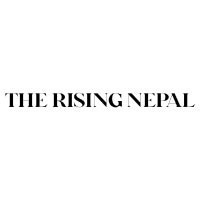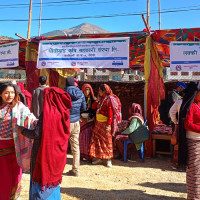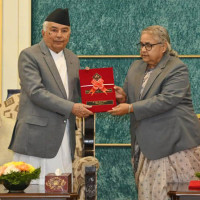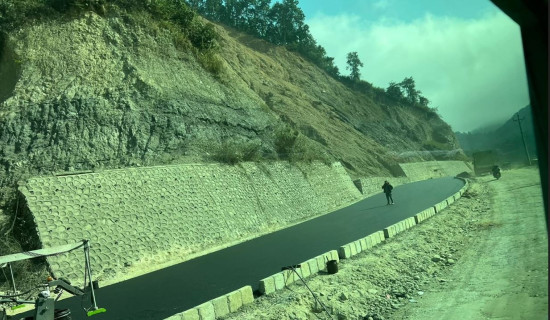- Monday, 15 December 2025
Nepali Army: Ultimate Defensive Shield
Unanticipated and unprecedented, the Gen Z movement led to the collapse of major state institutions after scores of youths were gunned down in front of the parliament building, the high seat of democracy, on September 8. A dreadful vacuum ensued, with shell-shocked political parties hiding to save their hides. The question of which force could emerge to protect the people and claim state authority frequently troubled the fearful citizenry as September 9 slipped into the night.
The people’s dilemma quickly came to an end as the Nepali Army personnel marched onto the streets, providing much-needed hope and confidence to the people. Given the gravity of the situation, the army’s arrival on the scene was not prompt enough. But the role it played in the decisive moments displayed its maturity, wisdom and sensitivity. It carefully coordinated things between the Gen Zers and the President to form a new civilian government tasked with holding a general election in March next year. The Sushila Karki-led interim government has also promised to bring those involved in the killing of protesters and destruction of public and private properties to book.
Responsibility
This time, the army was thrust to sort out a tricky job that it had never undertaken since it was born centuries ago. But, while accomplishing the monumental responsibility, it endured undue criticisms that largely stem from the poor grasp of the situation and the background in which the army was created and evolved. One blame heaped on it is: why did it not protect the vital buildings of Singha Durbar, federal parliament and courts, among others, while the protesters set fire to them?
The trails of destruction witnessed on September 9 were the direct reaction to the killing of at least 19 youths a day earlier. The arson and vandalism were further fuelled by the infiltration of the elements with vested interests. The latest media reports have exposed the penetration of cadres of rival political parties in the torching of private houses and government offices. The Nepali Army headquarters has already clarified that its troops stationed in the Singha Durbar fired more than 40 rounds in the air to disperse the protesters.
But their efforts failed to produce the desired outcomes as protesters in thousands barged into the Singha Durbar. As the situation got out their hand, the deployed troops allowed the irate crowds run amok inside the central secretariat of the federal government instead of shooting them down. The army could remove the agitators, but only at a cost of heavy casualties. The army could not open fire on the civilians on its own; it needed a legitimate order from the higher authority. On September 9, the army was denied written instructions from the relevant authority to control the situation on the ground, according to military sources.
Another logic is that the army could not remain a spectator when the Singha Durbar and the Supreme Court were in flames. Former army officers have countered this argument saying that if the soldiers had gone into action, more than a thousand of people would have lost their lives, triggering international outcry. The army would earn notoriety and the people would rise in revolt against it. This would attract international law and generate a pretext for foreign forces to intervene in the country's internal security. “In such a situation, the United Nations can ask Nepal’s neighbouring countries to send their troops to Nepal to restore peace and order here,” former Brigadier General Keshar Bahadur Bhandari says. He states that if the army fights against the external invasion, it becomes popular but if it is mobilised to control the internal conflict, it is subject to criticisms.
During the difficult moment of negotiation to install a caretaker government, a rumour that the army is plotting a coup went the rounds. Ironically, a sizable number of people, including journalists, political leaders and civic society members, were swayed by the hearsay. They still believe that the army wanted to impose its rule. This is utter naivety! The Nepali Army, which always ran under the command of the government of different hues, has no history of ruling the nation. Be it in a monarchy, the Rana rule, a democratic or republican dispensation, it has been loyal to the government and never crossed the red line.
Those who made wild guesses of army rule simply lacked the understanding of national capacity and geopolitical reality. Suppose the army took over the country, but it could not hold the reins for a long time, given Nepal’s excessive economic dependence on foreign nations. If one goes through the history of military rules or dictatorships, such regimes survive for a longer period only with greater economic advantage or rare natural resources, because of which the powerful foreign powers sponsor them.
Following the two-day Gen Z movement, major organs of the state had tumbled down. Even the Office of the President got jittery. It provided a perfect recipe for the army to take over the government. But the army chose not to pursue such a reckless path that might induce fatal consequences. Had it taken such a misstep, its credibility and popularity would have taken a hard knock at home and abroad. This would be a blot on its reputation that can hardly be erased.
Glorious history
The Nepal Army bears a glowing history of valour, sacrifices and diplomacy. A successor to the Gorkhali Army that was set up in 1560 following the founding of the Gorkha Kingdom, the Nepali Army grew in size and scale with the unification campaigns under its founder - Prithvi Narayan Shah. The Gorkhali soldiers defeated the British army at Sindhuligadhi in 1767, creating a momentum for uniting Nepal divided into dozens of principalities. In 2015, the Nepali Army skillfully executed 'military diplomacy' to end the unofficial Indian economic blockade on Nepal.
It has never tried to go against the popular will. But, whenever there are political upheavals, a section of people leaps to disparage it, calling for a reduction in its strength. They are unwittingly attacking an institution essential to safeguarding national sovereignty and ensuring critical security to the public. As seen in the Gen Z movement, it acted as the last line of defence when other security agencies were brought to their knees.
(The author is the Deputy Executive Editor of this daily.)














